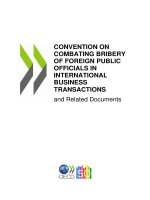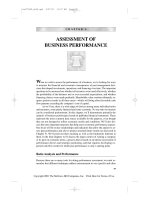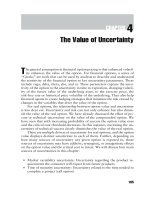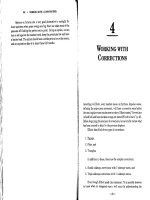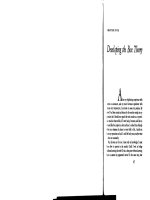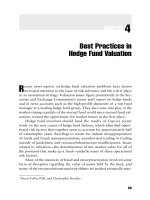Chapter4_International Settlement.pdf
Bạn đang xem bản rút gọn của tài liệu. Xem và tải ngay bản đầy đủ của tài liệu tại đây (3.59 MB, 53 trang )
Chapter 4
International payments
transactions
LOGO
Payment methods in international trade
LOGO
Similar to those in domestic trade
Added risks involved in cross-border transactions
Means of payment = terms of payment in international
trade
Four commonly used terms of payment – each of them
defers in level of risk and stability for buyer and seller.
Absolute v. relative security of parties (compromise of
the parties interests)
Key factors determining the payment
method
LOGO
Relationship between the seller and the buyer
The length of business relationship between the parties
(most important factor)
Nature of merchandise
Industry norms
Distance between seller and buyer
Currency fluctuations
Political and economic stability
LOGO
There is a mismatch between
Buyer and Seller Goals
When do YOU want to get paid?
When do Buyers want to pay?
Now!
Later!
4
Choice of Methods
LOGO
(What Determines?)
Buyer-Seller Relationship
Buyer’s credit standing
Competition
Uniqueness of the product (custom made?)
Country conditions (political, economic)
Cash flow considerations
Transaction costs
Other
5
Payment risk diagram
6
LOGO
How to transfer money between banks
Vostro Account
When a foreign bank maintains a current account with a local
bank ,from the point of a domestic bank, the account is a vostro
account
Nostro Account
When a domestic bank maintains a current account with a
foreign bank ,from the point of a domestic bank, the account is a
nostro account
Vostro a/c
(1)in cover,we have credited
you’re a/c with us
Remitting bank (2)in cover,please debit our a/c
with you
Paying bank
Nostro a/c
LOGO
1. Remittance
LOGO
Remittance refers to a bank (remitting bank), at
the request of its customer (remitter), transfers
a certain sum of money to its overseas branch
or correspondent bank (paying bank) instructing
it to pay a named person domiciled in that country
Parties of a remittance
-- Remitter
-- The Remitting Bank
-- The Paying bank
-- Beneficiary or Payee
Methods and procedures of remittance
LOGO
Remittance can be classified as M/T、T/T、 D/D
Remittance by mail (M/T)
the remitting bank transfers the funds by mailing a
P.O.
cheap but slow
Telegraphic Transfer
the remitting bank sends the P.O. to the paying bank
by cable, telex, or SWIFT, authorizing the paying bank
to make payment to the payee.
fast ; safe ; limited time for banks to keep the funds
Methods and procedures of remittance
LOGO
Procedures of M/T、T/T
(8)
Beneficiary
Remitter
(1)
(2)
Remitting
bank
(4)
(3)
(5)
(6)
Paying
bank
(7)
(1)Remittance application with funds and commission;
(2)receipt
(3)sends P.O. /telex/SWIFT instructing paying bank to make payment
(4)after authenticating, notifies the payee
(5)upon receipt, the payee provides the paying bank a receipt
(6)the paying bank debited the remitting bank’s a/c and make payment
(7)sends the debit advice and payment receipt from payee to the remitting bank
(8)the debt is discharged
Methods and procedures of remittance
LOGO
Remittance can be classified as M/T、T/T、 D/D
Remittance by Bank Demand Draft
the remitting bank draws a bill of exchange on
the paying bank ordering the latter to pay on
demand a certain sum of money to the beneficiary
who will also be the payee of the draft.
convenient and transferable
Application of remittance
LOGO
Payment in advance
--The time of payment comes before the delivery of
goods or the provision of services
--This method is favorable to the exporter while putting
the importer at a great risk of non-delivery
Application of remittance
LOGO
Characteristic of payment in advance:
- Full or significant partial payment is required, usually
through a credit card or a bank or wire transfer before
the ownership of the good transferred
- Cash in advance, especially a wire transfers: most
secure and favourable method of payment for exporters
and least secure for importers
• Pros: payment before shipment and eliminates risk of
nonpayment
• Cons: May loss customers to competitors over
payment terms
- No additiona learning through financing operations
Application of remittance
LOGO
• When use Cash in advance term?
• Importers is a new customer and/or has a lessestablished operating history
• Importer’s credit worthiness is doubtful,
unsatisfactory or unverifiable
• The political and commercial risks of the importer’s
home country are very high
• Exporter’s product is unique, not available
elsewhere or in heavy demand
• Exporters operate an Internet-base business where
the acceptance of credit card payment is a must to
remain competitive
Application of remittance
LOGO
Open Account
-- Exporter will make the delivery of goods or the
provision of services before importer makes payment
-- This method is favorable to the importer while putting
the exporter at a great risk
Application of remittance - Open account
LOGO
Under this method, this is absolute trust bw exporter
and importer built up over many years of trading
relationship
Exporter provides credit for importer by honour at future
date
Open account trade is a generous credit facility
extended by exporter to the importer to enable him to
find buyers for the products
Role of banks:
- Providing the services for transfer payment at the due
date
- Financing for exporter by factoring...
Application of remittance
LOGO
Open account
-Characteristics
– Risk: Exporter faces significant risk as the buyer could
default on payment obligation after shipment of the goods
– Pros:
+Boots competitiveness in the global market
+Establish and maintain a successful trade relationship
– Cons:
+Importer insolvency
+Additional costs associated with risk mitigation measures
Application of remittance
LOGO
Consignment
-- Exporter ships the goods to the importer and
retains the title to the goods until the importer make
payments
-- This method is favorable to the importer while
putting the exporter at a great risk
Questions:
LOGO
2. Collection
2.1. Definition of collection
20
LOGO
2. Collection
LOGO
2.2. Parties to a collection
1. The "principal" who is the party entrusting the
handling of a collection to a bank;
2. The "remitting bank" which is the bank to which
the principal has entrusted the handling of a
collection;
3. The "collecting bank" which is any bank, other
than the remitting bank, involved in processing the
collection;
4. The "presenting bank" which is the collecting
bank making presentation to the drawee.
21
2. Collection
LOGO
2.3. Classification
2.3.1.Clean Collection
Collection of financial documents not
accompanied by commercial documents.
- Financial documents:bills of exchange, promissory notes,
cheques, or other similar instruments used for obtaining the
payment of money
- Commercial documents:invoices, transport documents,
documents of title or other similar documents, or any other
documents whatsoever, not being financial documents
22
LOGO
2. Collection
Clean Collection Procedure
Principal
(Seller/Exporter)
(2)Document,
Draft
(Sales Contract)
(1)Send Goods
(4) Document,
Draft
(7)Payment/
Acceptance
Remitting Bank
(Seller’s Bank)
Drawee
(Buyer/Importer)
(3)Document,
Draft
(6)Payment/
Acceptance
23
(5)
Payment/
Acceptance
Collecting Bank
(Buyer’s Bank)
2. Collection
LOGO
2.3. Classification
2.3.2. Documentary Collection
A documentary collection (D/C) is a transaction
where the exporter (principal) entrusts the collection
of payment to the exporter's bank (remitting bank),
which sends documents to the importer's bank
(collecting bank) along with instructions for payments.
Funds are received from the importer and remitted to
the exporter through the banks in exchange for those
documents.
24
2. Collection
LOGO
2.3. Classification
2.3.2. Documentary Collection
Documents against Payment – D/P
Requires the importer to pay the face
amount of the draft at sight.
The payment must be made to the bank
before the buyer's bank or collecting bank
releases the documents.
A D/P is also called a Sight Draft or Cash
Against Documents.
25


